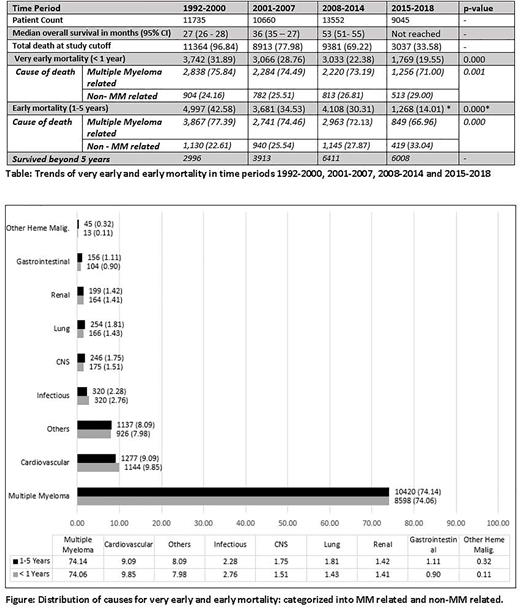Abstract
Introduction: Long term survival of patients with Multiple Myeloma (MM) has been well studied and has improved over time owing to better understanding of disease biology, development of newer drugs, hematopoietic stem cell transplantation and surveillance. However, there is limited literature available looking into early mortality, even when a significant percentage of patients still die within a few years of diagnosis. Our objective was to determine the trend in MM and Non-MM related causes of very early (< 1 year) and early (1-5 years) mortality over the last 25 years.
Methods: We identified patients with MM as first primary malignancy from the Surveillance, Epidemiology and End Results (SEER), 12 registries database for the 1992-2018 period using WHO ICD-O-3 codes. Demographic details, year of diagnosis, survival months, vital status and cause specific mortality until the study cutoff (December 31, 2019) were collected. Patients without survival months were excluded. The trend in overall survival over 1992-2000, 2001-2007, 2008-2014 and 2015-2018 time periods were compared by log rank test with p-value adjusted for multiple comparison between each time-period with Bonferroni correction. Non-Myeloma related causes including solid malignancies were categorized in broad 8 categories. Very early and early mortality were compared over the four time periods by Chi square method. P-values < 0.05 were considered statistically significant.
Results: A total of 45,803 patients were identified in the SEER database. 811 patients with no survival data were excluded. A total of 44,992 patients were included in the final analysis. Among them, 28.6% (n=12,868) patients were of age up to 60 years, 42.24% (n=19,006) patients were of age 61-75 years and 29.16% (n= 13,118) patients were >75 years. 53.98% (n= 24,288) were Males. According to ethnicity, Non-Hispanic Whites were 62% (n=27,898), Non-Hispanic Blacks were 15.83% (n=7,124) and Hispanic were 12.45% (n= 5,603). Overall survival increased significantly over four time-period (adjusted p-value < 0.005 for all the comparison between each time-period). Median survival also increased from 1992-2000 to 2008-2014 time-period and not reached for 2015-2018 (Table). 72.68% (n= 32,695) patients died over the study duration. 72.42% (n=23,679) death were related to MM, whereas Non-MM related deaths were seen in 27.58% (n = 9,016) patients (Table). Among Non-Myeloma related deaths, the most common causes of very early mortality (<1 year) were CVS disease (9.85%), Infectious etiology (2.76%), CNS disease (1.51%) and Others (7.10%). The most common causes of early mortality (1-5 years) among non-myeloma related causes was CVS disease (9.9%), Infectious etiology (2.28%), Lung disease (1.81%) and others (7.22%) (Figure). Very early mortality was noted to decrease significantly from 31.89% for 1992-2000 to 19.55% for 2015-2018 (p-value 0.00). Early mortality improved significantly from 42.58% in 1992-2000 to 30.31% in 2008-2014 time-period (p-value 0.00). Proportion of myeloma related mortality decreased significantly for both very early (p-value - 0.001) and early mortality (p-value 0.000) for entire study duration.
Conclusions: Early mortality in MM has been decreasing but remains a significant challenge. When compared to MM related causes, proportion of Non-MM related causes to early mortality have been increasing. Cause specific targeted approach like life style modification, screening and infection prevention should be implemented early to further improve the early mortality in this risk prone population.
Disclosures
No relevant conflicts of interest to declare.
Author notes
Asterisk with author names denotes non-ASH members.


This feature is available to Subscribers Only
Sign In or Create an Account Close Modal